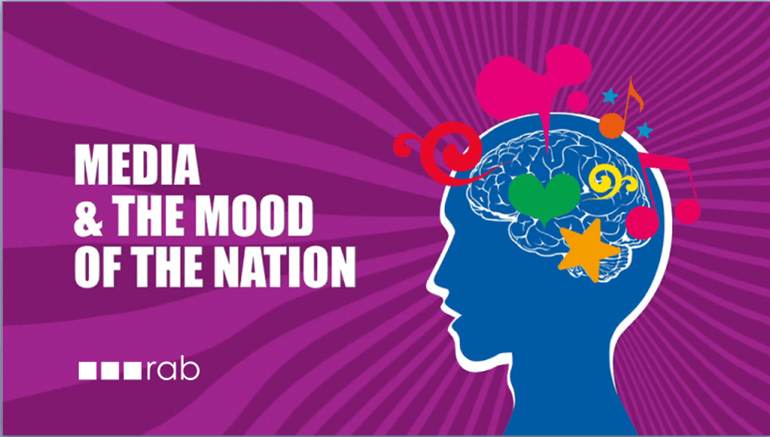Contents:
- Introduction
- Summary of key findings
- Executive summary
- Background
- How the study was done
- Radio’s emotional multiplier effect: detailed findings
- Findings from the smartphone users survey
- Findings from the EEG neuro-test
- Implications for advertisers
- References
Introduction
Britain Loves Radio!
At least that’s what all the audience stats suggest, with RAJAR showing that radio is listened to by more people than ever, and IPA Touchpoints highlighting that it is the second biggest medium in people’s lives after TV.
Yet despite all this listener love, radio seems resolutely typecast as a tactical advertising medium; restricted to delivering the rational messages within the ad campaign, tasked with prompting a response or driving the sale.
Now don’t get us wrong – radio is incredibly effective at mobilising its listeners to generate business for advertisers, as proven in previous RAB research studies and the myriad results-led case studies on the RAB website.
But it seems that many advertisers remain indifferent to radio’s brand building potential, unconvinced about the ability of an image-less medium to influence brand perceptions.
And that’s why we commissioned this study – to understand the emotional influence of radio relative to other media, and explore how this can benefit advertisers seeking to build brands.
The findings deliver a potent reminder of the influential emotional role that radio plays in people’s lives and suggest that, beyond its current tactical function, the medium should be given far greater consideration for brand communication plans.
If you’d like to find out more about how radio could help build your brand, please give the RAB team a call – we’d love to hear from you.
Summary of Key Findings
“Media and the mood of the nation” is a new research study (conducted by Sparkler Research in Spring 2011) that set out to explore how media improve people’s mood. This subject was of particular interest because academic and advertising research shows that ad messages work better in mood-enhancing media.
The five key findings from the study are:
- Consuming any medium (TV, Online, Radio) has a significant uplift effect on people’s mood
- Radio generates the highest happiness and energy levels of the three media measured, and on more occasions
a. On average, when consuming radio, Happiness & Energy scores increase by 100% and 300% compared to when no media is being consumed
b. Radio is the highest scoring medium for Happiness & Energy in 70% of dayparts across the week
c. Radio is also part of the most potent mood-enhancing media combination, when consumed in combination with online - This mood-boosting effect of radio editorial extends into the ad break generating 30% higher levels of positive engagement with radio advertising
- So for advertisers, radio represents a unique and powerful opportunity to reach consumers in a positive frame of mind, when they will be more receptive to advertising messages
From this we conclude, that for advertisers:
Radio is a powerful Emotional Multiplier, boosting consumer happiness and enhancing receptiveness to advertising
Executive Summary
The study in a nutshell:
People use media to make themselves feel happier, and happier people are more inclined to respond to advertising in an instinctive, emotional way. This study shows that radio excels as a “feel-good” medium, and importantly that this effect extends into enhanced consumer engagement with the advertising.
Why and how the study was done
Three separate developments, related to “the mood of the nation” have contributed to this study:
- recent advertising effectiveness thinking suggests that ads which have an emotional appeal are more effective than those which just use rational arguments
- academic research suggests that we process such messages heuristically, i.e. more instinctively, less critically and in a way that is strongly influenced by context – and that we are more inclined to do this if we are in a happier mood
- media industry research continually demonstrates that people use media to affect their mood, rather than purely for information or interest
So this study asked: to what extent do media exert a positive influence on the way people feel, how does this happen and how does this affect engagement with advertising – especially on radio?
The study used the findings of the “Media and the mood of the nation” research project conducted by Sparkler Research in Spring 2011. Following an in-depth qualitative pilot, 1000 consumers took part in a smartphone-based survey about their mood and media consumption. This was supplemented by neuro-science based lab investigation into the way the brain responds to audio content.
The results
1. Media consumption has a significant positive effect on people’s mood
When the respondents reported their media usage and their perceived levels of happiness and energy across the week, there is a clear correlation: people who were consuming media had higher scores for both energy and happiness.
2. Radio has the biggest influence on people’s Happiness and Energy, and on more occasions
Radio is the highest scoring medium (compared to TV and online) for increasing both energy and happiness. This is true across all days of the week and almost all times of day.
3. This radio editorial effect is proven to enhance engagement with advertising
EEG tests in the lab confirm that radio stimulates positive engagement activity in the brain. They also confirm that when ads are preceded by radio editorial, levels of positive engagement are sustained throughout the ad break.
4. Using the findings to inform planning
For advertisers, radio represents a unique and powerful opportunity not just to influence how consumers feel about brands, but also to do so efficiently at important times for the brand across the week.
Part one: Introduction
Background
This study, focusing on the way advertising in media (and radio in particular) works, is based on “Media and the mood of the nation”, a study conducted by Sparkler Research for the RAB in Spring 2011. The mood of the nation is very much on the agenda at this time, with the Coalition Government using it as an indicator of economic wellbeing, and the launch of Lord Layard’s much-discussed Action for Happiness initiative, a movement committed to building a happier society.
Recent thinking about advertising effectiveness suggests that messages with an emotional appeal have a stronger effect, and a bigger return on investment, than those which rely purely on rational argument (for more details see the IPA’s “Marketing in the era of effectiveness” and Brainjuicer’s “Using an emotional model to improve measurement of advertising effectiveness”).
As this chart explains, ads which work at the emotional level are processed heuristically rather than systematically, and this kind of processing is strongly influenced by context – where we see/hear the message, the quality of the message and, centrally for this study, the mood we are in when we receive the message.
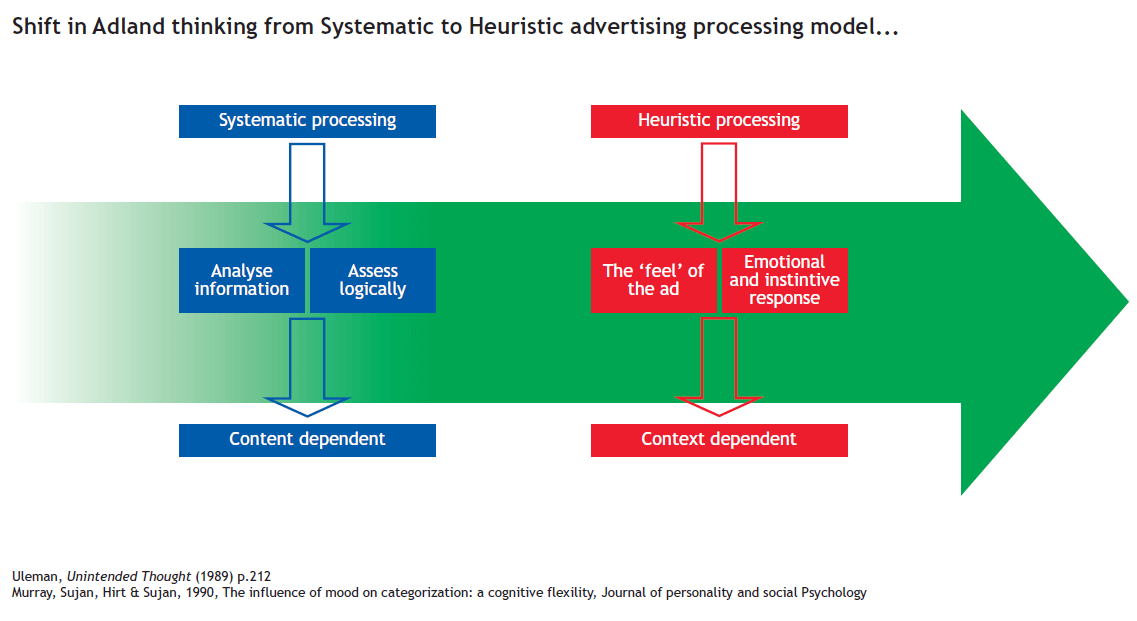
Importantly, studies suggest that the happier we are – the better a mood we are in – the more likely we are to process messages in this heuristic way (see more details on page X) Check with AI – what referring to?
At the same time it’s well known in the media industries that, although people often claim to use media purely for information or interest, much of the time they are using it to influence their mood or state of mind – as a relaxant or a stimulant.
So these developments in advertising raise some important questions about the way different media affect people’s processing of ad messages and particularly, from a radio industry point of view, the way this might relate to radio advertising.
Questions we set out to answer
- To what extent do media exert a positive influence on the way people feel?
- How and when does this happen, and how does it vary by medium?
- How does this affect engagement with advertising, particularly for radio?
How the study was done
The core of the study was a smartphone-based survey of 1000 respondents, who were asked about their mood at various times, and this was cross-tabulated against their media consumption (or non-consumption) at those times.
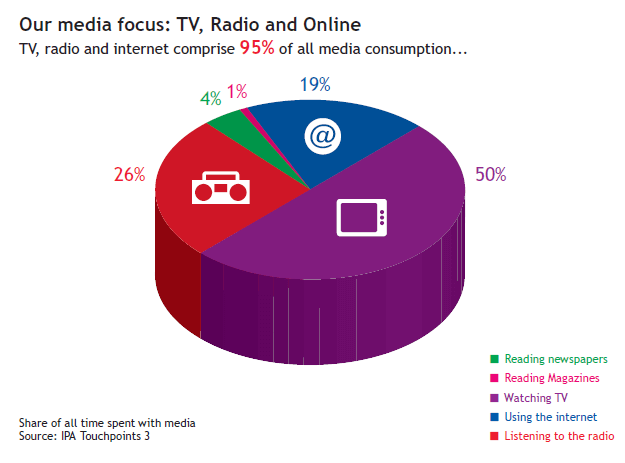
a) Media selection – TV, Radio & Online
Media consumption is highly complex in today’s world of ambient media, sponsorships etc, so to simplify the issue we focused on consumption of three media only – TV, radio and online. Together, according to IPA Touchpoints, these account for 95% of total media consumption time across the week.
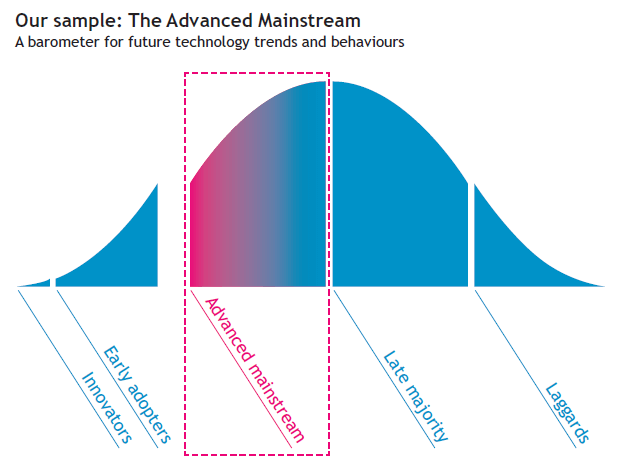
b) Respondent selection – “The Advanced Mainstream”
The sample broadly reflected the UK population in terms of age and commercial radio listening, but to ensure that the findings provide not just a snapshot of the present but also act as a barometer for future technology trends and related behaviours, all were classified as in the “advanced mainstream” group in terms of technology. To fall into this group, respondents had to conform to two additional criteria:
- They had to be smartphone users
- They had to use the internet for entertainment (i.e. not just for search)
c) Measuring mood states – Happiness and Energy
The research was based on Russell’s (Russell, 1980) circumplex model of affect to measure mood. The key scales on this are Valence (i.e happiness) on a positive to negative scale, and Arousal (i.e. energy) also on a positive to negative scale.
d) Three stages of study
(i) Pilot study
Depth interviews to explore the connection between media and mood and help shape how the main study should best be conducted. This included how people responded to questions about mood, the language used, a written diary exercise of media usage and mood recorded over four days, video snapshots of the experience, etc (6 respondents)
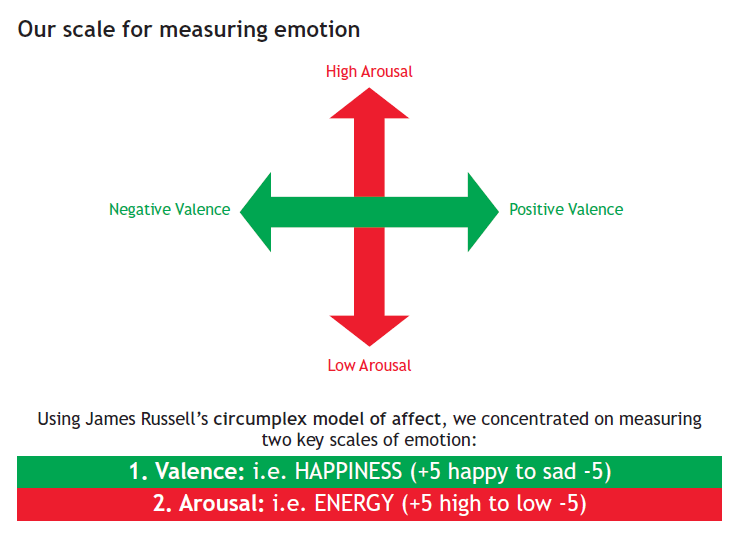
(ii) Main study
1000 smartphone users who were sent a “prompt” to respond to questions via their handset at various times of day and on different days of the week, supplying details about:
- their location (home, car, workplace, etc)
- any TV, radio or online being consumed
- aspects of their mood (on scales of -5 to +5)
- free text comments about why they felt that way
(iii) Neuroscience study
This was an in-depth if small-scale EEG (or “brain scan”) test conducted with 6 participants following the main study to explore what happens to levels of engagement when people are listening to different elements of radio output.
The research took place across Spring 2011 and was conducted at all stages by Sparkler Research.
Part two: Radio’s Emotional Multiplier Effect – Detailed Findings
A. FINDINGS FROM THE SMARTPHONE SURVEY
The 1000 smartphone users who agreed to take part in the research were sent a text “prompt” asking them to respond to our questions at various times of day and on varying days of the week. For simplicity of analysis the day was divided into four dayparts (Breakfast, Daytime, Drive-time, Evening) and the week into four segments (Monday-Thursday, Friday, Saturday, Sunday), acknowledging the days on which behaviour and mood are most likely to vary from the norm.
This simplified week structure allowed us to build stable samples for comparison for each medium across the days and dayparts – the survey targeted a minimum of 50 responses per medium per daypart for each day.
To ensure a high response rate and quality of response, the survey was developed to be as simple and effortless for the participants as possible. On each occasion they were prompted, respondents were asked to give answers on four screens, as detailed in the schematic.
(NB – mock up each of the four screens on a mobile phone with arrow behind – MB/SO)
These questions allowed the researchers to identify how people were feeling:
- when consuming none of the three media (“No Media”) to provide our Base Level
- when consuming any TV, radio or online, one at a time or in combination (“Any Media”)
- when consuming a specific medium (“Individual Media”)
a. Base Level: ‘No Media’ scores
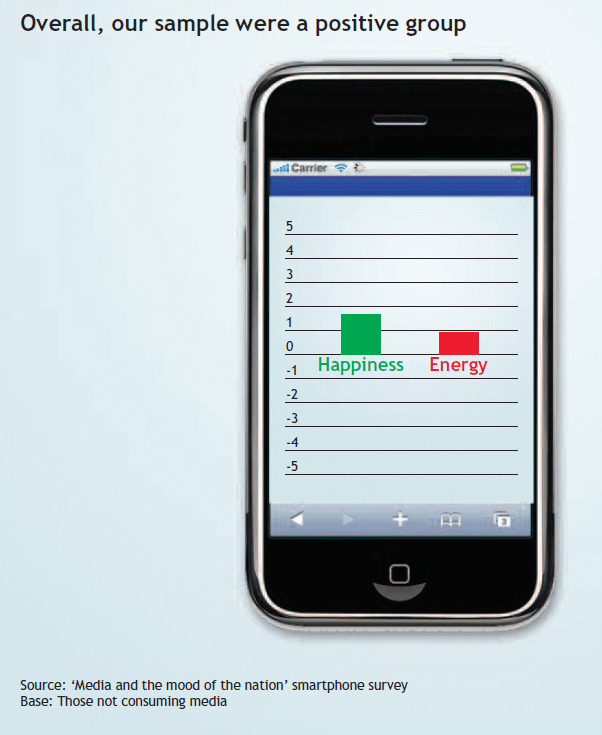
The No Media reading was used as the base level for comparing subsequent scores of happiness and energy in the test (bear in mind that only TV, radio and online are included here – people consuming ‘No Media’ at the reporting time could have had access to e.g. a newspaper or magazine (however, with IPA Touchpoints data showing that all other media account for around 5% of the media day, the incidence of this will be relatively low).
On average, the respondents gave themselves a slightly positive score on both happiness and energy when consuming No Media, with men scoring somewhat higher than women. Levels also vary by age with younger people in general scoring lower for Happiness and Energy.
The No Media base levels for energy and happiness both change across the day: predictably Happiness increases as the day progresses, but Energy peaks during the daytime when people are most active, falling in drive-time as a sense of exhaustion sets in, only to rise again as spirits lift in the evening.
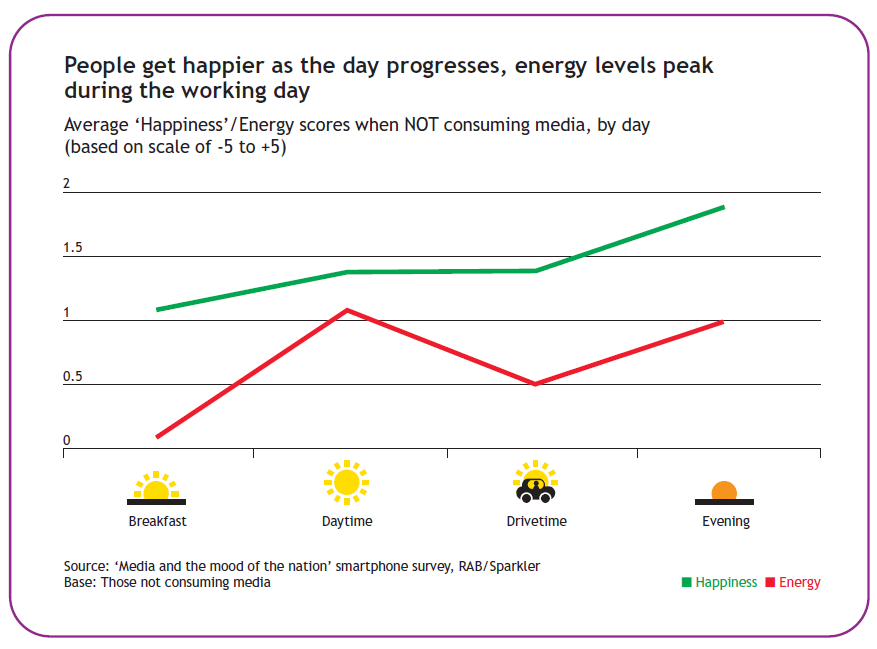
Interestingly, Energy levels are highest during the week. While Happiness levels show a peak on Saturdays, Energy shows a very clear fall across the whole weekend, as people take the opportunity to relax and recharge their batteries ready for the following week.
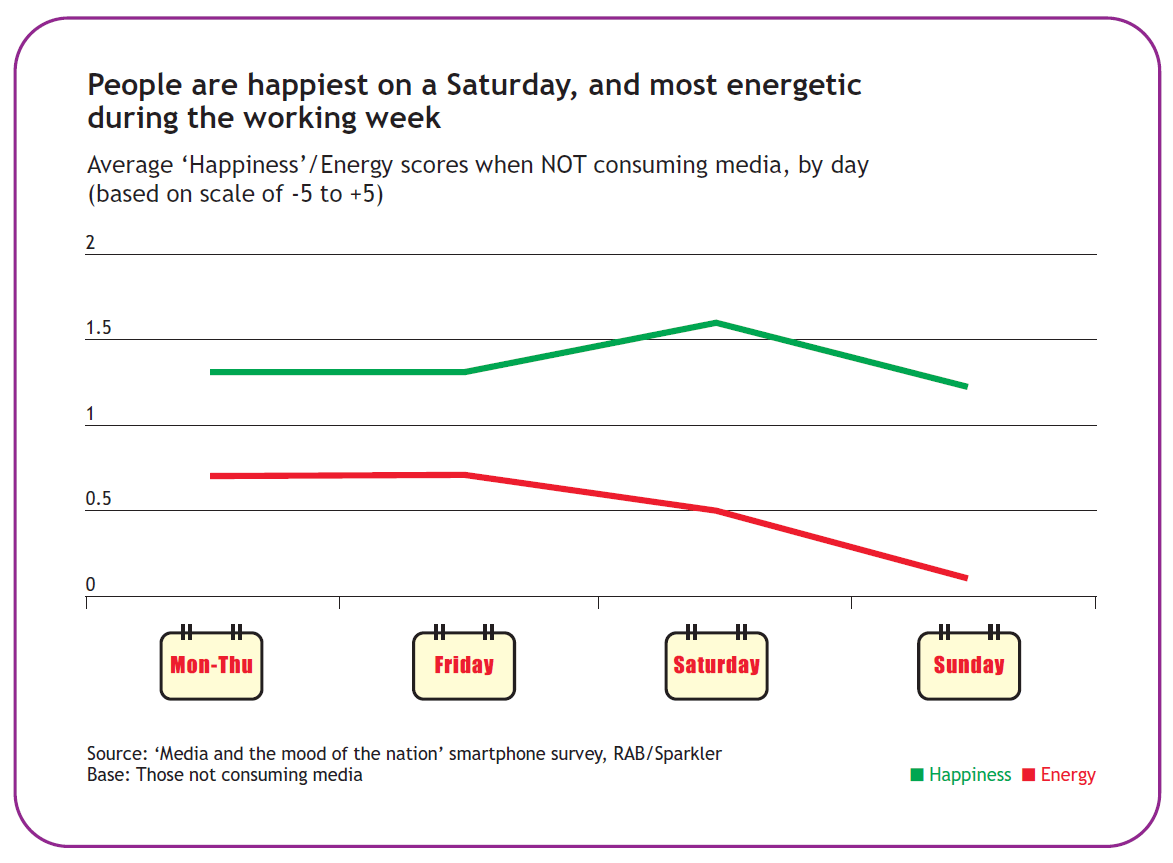
b. ‘Any Media’ scores
Having established a base level for the study with not consuming media, we move on to explore how ‘Any Media’ consumption influences the mood scores of people.
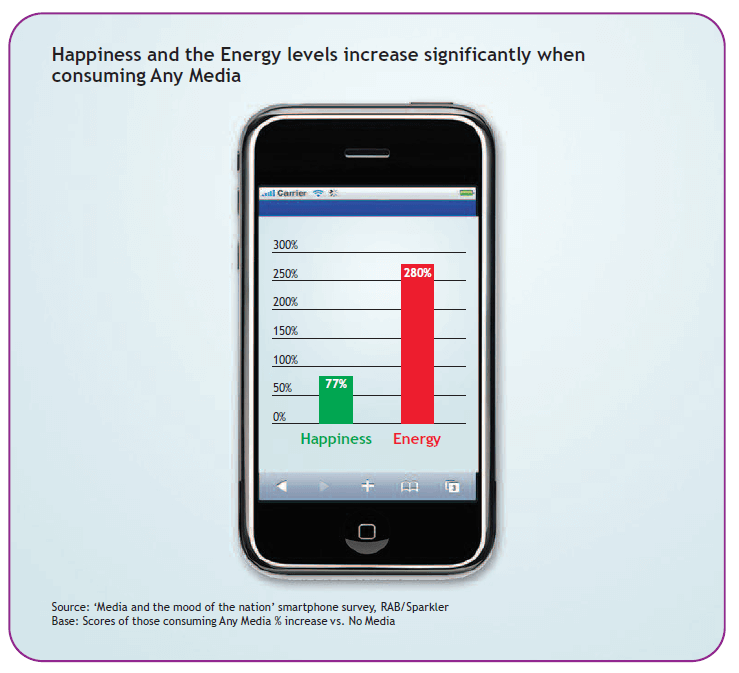
There is a very clear finding at the overall level in this category. People consuming ‘Any Media’ show significantly higher indices for both Happiness and Energy levels than people consuming ‘No Media’.
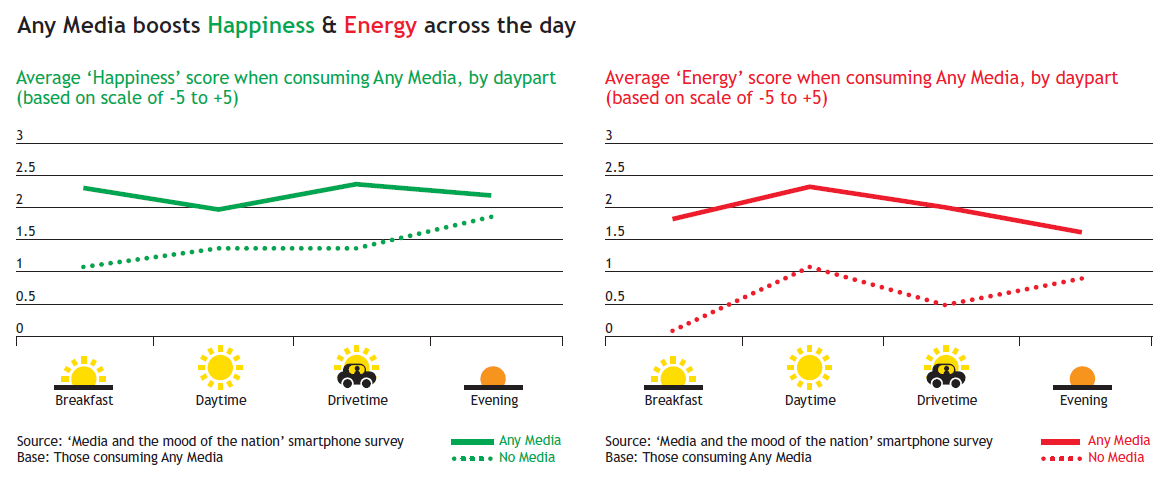
Any Media scores for Energy are much higher than the base level (No Media) all across the week, and show the biggest boost on Sundays. Happiness scores show a similar pattern, with the biggest gains on Fridays as well as Sundays.
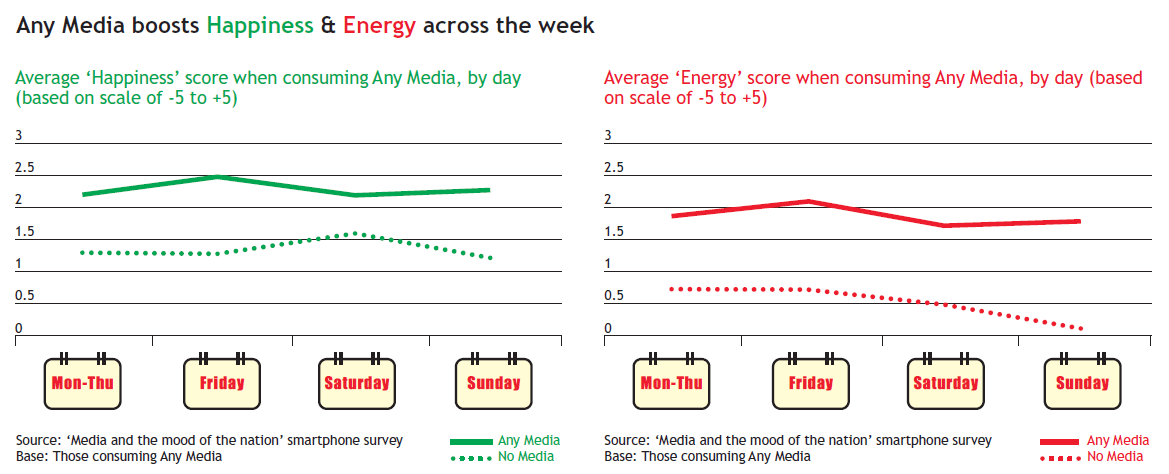
In terms of daypart, these gains were most visible in the Breakfast and Drivetime categories.
These comparisons give the important and unequivocal finding that people who are consuming any media (of TV, radio or online) feel much happier and significantly more energised than people who aren’t consuming media.
c. ‘Individual Media’ scores
Having established the significant effect of consuming any medium on mood, we then moved on to look at the scores of people who were consuming either TV, or radio, or online in isolation.
When we look at the headline pattern, as the chart shows, people consuming radio are much Happier and more Energetic than those consuming TV or online.
When we drill down into different dayparts and days of week, sample sizes become too small to give meaningful trends at a solus media consumption level because a high proportion of respondents were consuming two or more media at the same time. However we have been able to analyse each medium based on any occasion it has been consumed – whether in isolation or with another medium. (The high proportion of concurrent media consumption reflects an increasing trend which has also been picked up in other studies e.g. IPA Touchpoints, Ofcom)
So when looking for variances by medium over the day or across the week, we have reviewed each medium based on any occasion it has been consumed – whether in isolation or with another medium.
Unsurprisingly, the scores for people who are consuming ‘Any TV’, ‘Any Online’, or ‘Any Radio’ all show a similar pattern when compared to those consuming ‘Any Media’ (see section b. above).
In terms of Happiness, all media show a significant increase compared to base levels on every day across the week, with the biggest increments occurring on Fridays and Sundays. In general, the Happiness scores for Any TV, Any Online, and Any Radio users are comparable with Any Media users – although radio shows an exception because it has a particularly strong peak for increased happiness on Fridays (“that Friday feeling” which radio stations cultivate).
There is a very similar story for energy levels, with all three media showing increases compared to base levels across the week and especially on Sundays.
So whilst it’s true to say that the three media show more commonality than differences, suggesting that they have a broadly similar effect on people’s levels of Happiness and Energy – it’s clear that radio has the strongest effect of all. Detailed analysis of Individual Media by daypart by day (see chart below) indicates that this pre-eminent position is prevalent across all days of the week and almost all dayparts.
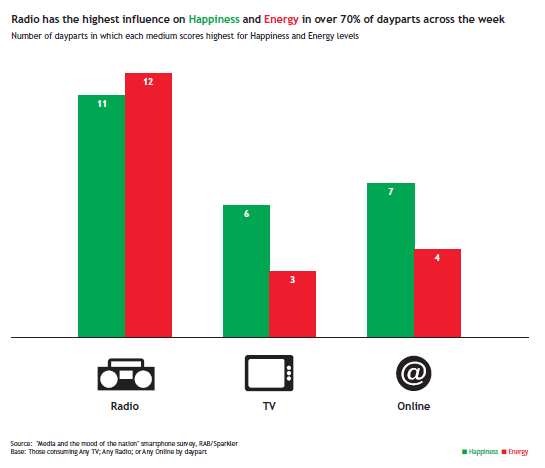
d. Qualitative aspects of media usage
The data so far has demonstrated that all three researched media generate uplifts in people’s levels of Energy and Happiness, but of course this is not to suggest that they are all playing the same role in people’s lives.
People use TV, radio and online for different reasons and the qualitative stage of the study gave some insight into how this varies for each medium.
|
Medium |
Characteristics |
Things people said |
|
TV |
Communal – often a shared medium Escapism – takes you elsewhere Roller coaster – strong involvements but sudden interruptions and endings Varying intensity – morning TV more distracted
|
“The TV is on and I’m with my family which is givin me happy vibes” “Chilled me out as it’s keepin the kids entertained” “Little stressed at min but TV helping me to relax” “Watching daybrake with a cuppa and some toast”
|
|
Radio |
Companion – keeps you going, offsets isolation and stress Connected – links you to the world outside Energising – stimulant role Feelgood factor – typically well-loved music
|
“It lifts me and makes the day less boring” “Needed a lift! Endorphins and tunes a good combo” “Long day at work but a good day, and it’s almost the weekend!” “Radio in the background, humming along to a few songs, feels good!” |
|
Online |
Responsive – allows direct access, now Fulfilling – completes tasks and purchases etc Adaptable – lets you manage your content Surprising – new uses and applications
|
“On the internet doin research and listenin to music at the same time” “Job searchin and feelin a bit more upbeat” “Trying to sort something out with my bank” “Been on Flirtomatic for about three hours”
|
Given that Television’s central role lies in the area of escapism and entertainment, it’s perhaps surprising that it does not score highest of the three media for generating increases in happiness. Evidence suggests this may be because the key strength of TV – its ability to transport you elsewhere – brings with it an inevitable flat feeling when you return to the real world. And whilst live ‘event’ TV (such as X-Factor) is undeniably incredibly powerful content, it is simply not possible to sustainably fill the schedules with this genre of programming in today’s multi-channel 24-hour TV broadcasting world. These results suggest that the reality of day-to-day TV programming, whilst still highly valued by viewers and advertisers, has less effect on the viewer’s mood than perhaps anticipated.
The role of Online is still developing of course, as the user’s experience of internet based services becomes more blurred with other platforms e.g. the TV screen, the phone, the radio, etc. But it’s clear from these comments that part of the reason why people like accessing things online is the multiplicity of possibilities it offers – beyond the functional offering of search, the internet is home to easily accessible myriad entertainment such as gaming, music, social contact, and beyond. Respondents explained how they felt a sense of achievement if they found what they were seeking online. However, they also raised their irritations with the internet, e.g. the misdirection of some links, and the frustration they experienced when streamed content was buffering.
Meanwhile these qualitative inputs help to explain why Radio generally outperforms the other media in terms of generating happiness and energy. Firstly, people use it to generate exactly that, happiness and energy. It’s chosen as a kind of lifestyle support system, to help people feel better as they go about their daily lives. In this context, it was interesting that some respondents participating in the qualitative phase talked about how they didn’t realise how important radio was to them until they had participated in this exercise.
Secondly, the nature of radio programming also plays a role. Rather than the peaks and troughs that people claimed to experience with TV and Online, Radio provides a consistent environment themed and shaped to suit the listener’s needs at any given time of day, and one that is generally upbeat in tone (this subject was explored in more depth in the RAB publication, The Nature of Radio Relationships).
Alistair Campbell (previously Tony Blair’s Director of Communications and Strategy) recently highlighted how the tone of British media has fundamentally altered over the last three decades -from three positive stories for every one negative story in the 1970s, to eight negative stories for every one positive story today. Commercial Radio is a clear exception to this rule, and this may also help explain the more positive influence of the medium on the listener’s mood.
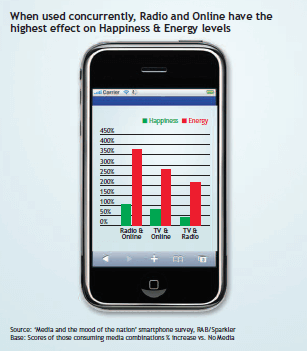
e. Media combinations
As we have already referred to in this report, the research recorded a high level of multi-media consumption – in fact, around 50% of all media consumption occasions involved more than one medium.
There are many media research studies that highlight the multiplier effect of media combinations on advertising effectiveness. As the chart suggests, there also appears a multiplier effect of combining media on people’s Happiness and Energy levels. Data suggests that the combination that has the most positive effect on how people feel is Radio and Online, which reflects earlier learning from RAB & IAB about the compatibility of the two media (see the report ‘Using radio with online’ on the RAB website).
B. Findings from the EEG brain scan
Having established the way that media improve people’s feelings of Happiness and Energy, we needed to find out more about what this means for advertising.
Specifically we wanted to find out whether the positive mood created by radio editorial extended to radio advertising – or might listeners disengage when the ads came on?
Details of the method
EEG (Electro-Encephalography) using 64 electrodes attached to the heads of participants was used to detect electrical impulses, second by second, in their brains while they were exposed to a series of audio stimuli:
- radio editorial
– edited from actual radio output from the previous week
– featuring presenter conversation & song fragment - radio ads
a. representative mix of radio ads taken from RadioGauge database
b. mix of different creative approaches
c. strong and weak performers based on RadioGauge results - silence
Participants were asked to complete a simple 40-minute typing task to simulate normal radio listening conditions and to “naturalise” conditions as much as possible.
The audio material was structured so that we could measure levels brain activity:
a) when the radio content was playing, compared to silence
b) when radio ads were preceded by radio content, compared to ads without preceding radio editorial

In particular, this experiment focused on exploring Gamma band activity, which indicates a high level of brain activation. When Gamma band activity is prevalent in the left hemisphere of the brain, which is associated with ‘approach’ behaviours, the brain is responding positively to the stimulus, and displaying signs of ‘positive engagement’.
Results
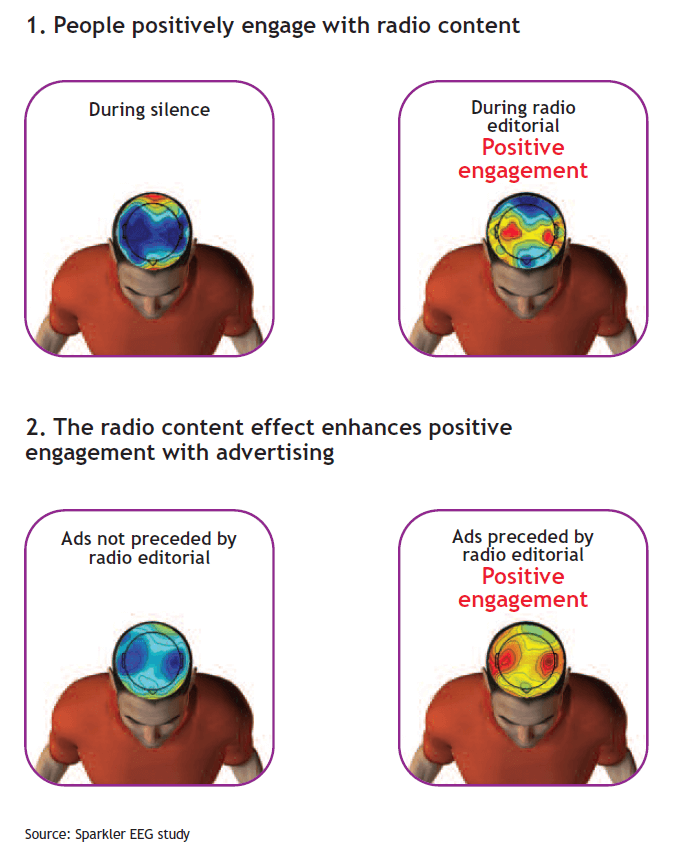
The EEG data represents high-levels of brain activity as a red-coloured area – when the activity subsides the colour indicated is blue.
As the EEG charts show below, average levels of left hemisphere Gamma activity were very clearly raised in both of the comparisons we had set up:
• there was more activity in the left brain hemisphere while the radio was playing, compared to when it wasn’t – indicating positive engagement with radio content
• there was more activity in the left brain hemisphere when the ads were preceded by radio editorial, than when the ads weren’t preceded by radio editorial
A recent study (Vechiato et al., 2010) reported similar left hemispheric dominance in the gamma band while watching TV commercials, suggesting that radio engages people with advertising in a similar way to TV.
These findings suggest two significant conclusions:
• firstly, radio output creates high levels of positive engagement in the brain
• secondly, those levels of positive engagement extend to radio advertising when it is preceded by radio editorial
We therefore conclude that the mood enhancing effects of radio editorial extend into the ad break, generating higher levels of positive engagement with radio advertising.
Part three: Implications of ‘Media & the Mood of the Nation’ Study for Advertisers
- This unique multi-method study has three important conclusions:
- Media plays an important role in helping people feel more energetic and happier, and therefore creates a very positive context to enhance for advertising messages
- Radio generates higher levels of happiness and energy, and on more occasions across the week than TV and online
- The mood-enhancing effects of radio editorial extend into the ad break generating higher levels of positive engagement with radio advertising
These findings are particularly important for brands whose aim is to enhance positive brand perceptions. This study suggests that radio is a highly impactful means to delivering this, and should be strongly considered within the media mix.
The study also suggests that there is an opportunity for advertisers to flex their media usage to reach people at high happiness and energy moments. The additional benefit of radio within this context is that it is also able to reach people in the right mood at relevant times, as this Touchpoints data showing share of media time alongside consumer activities highlights. Use graphs not slides? Illustrate people were happier at drivetime – the only medium in peoples cars? Maybe? Maybe not?
If you would like to find out more about how Radio’s Emotional Multiplier effect could benefit your brand campaign, please give us a call.
References
IPA “Marketing in the era of accountability”
Les Binet, Peter Field, 2007
Brainjuicer “Using an emotional model to improve measurement of advertising effectiveness”
Orlando Wood, 2010
“Unintended Thought”
Uleman, 1989
“The influence of mood on categorisation: A cognitive flexibility”
Journal of personality and social psychology Murray, Sujan, Hirt & Sujan, 1990
“A circumplex model of affect”
Journal of personality and social psychology
Russell, 1980
“Mood & Persuasion: Affective states influence the processing of persuasive communications”
Advances in Experimental Social Psychology
Schwarz et al, 1991

